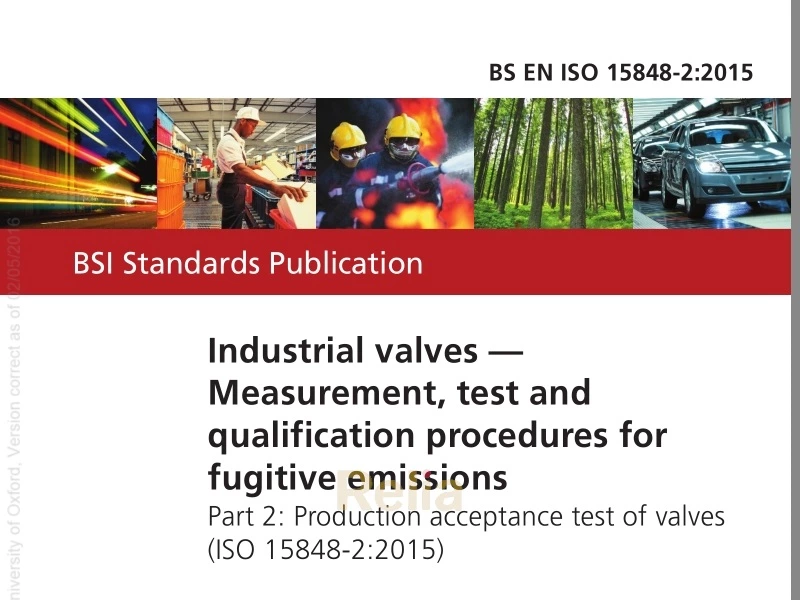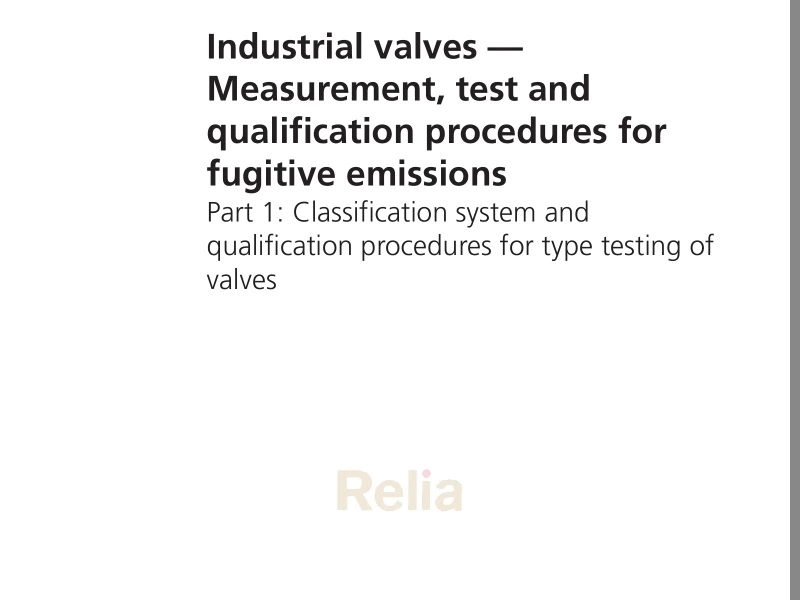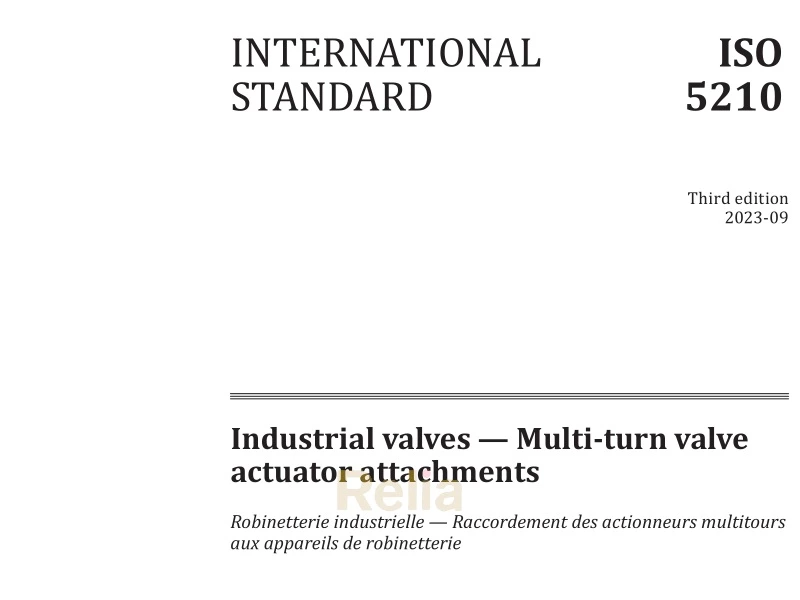ISO 22434: Gas cylinders —Inspection and maintenance of valves
ISO 22434 specifies requirements for the inspection and maintenance of valves including ball valves and valves with integrated pressure regulator (VIPRs).
1 Scope
ISO 22434 specifies requirements for the inspection and maintenance of valves [including ball valves and valves with integrated pressure regulator (VIPRs)]for:
a) refillable transportable gas cylinders;
b) cylinder bundles;
c) pressure drums and tubes;
which convey compressed,liquefied or dissolved gases.
This document does not apply to valves for liquefied petroleum gas (LPG).
NOTE Where there is no risk of ambiguity,gas cylinders,cylinder bundles,pressure drums and tubes are addressed with the collective term "gas cylinders"within this document.
ISO 22434 is applicable to valves reused at the time of the periodic inspection of gas cylinders, cylinder bundles,pressure drums and tubes,and can be applied at any other time,e.g.at a change of gas service (see IS0 11621).
This document does not apply to the routine inspection of valves,e.g.carried out at the time of a gas cylinder filling.
5 Inspection and maintenance
5.1 General
Inspection will determine if a valve is suitable for continued service or if maintenance is required,and the level of that maintenance.
If the manufacturer has declared a service life for a valve and when that service life has expired,the valve shall:
a) not be put back in service,or
b) if the intention is to extend the service life of the valve for an additional period,the valve shall be inspected and maintained in accordance with this document and in accordance with a specification agreed with the manufacturer or successor.
NOTE Applicable regulations can affect an extension of the service life.
5.2 Inspection
5.2.1 General
Inspection of valves comprises external examination preceded by cleaning,if necessary.
5.2.2 Cleaning
WARNING —Used valves can contain hazardous substances (e.g.toxic).A safety assessment should be performed to address any hazards associated with cleaning the cylinder valves.A procedure should be in place to protect personnel from any hazards identified in the safety assessment before cleaning the valves.Disposal of contaminates from the cleaning pro cess can be subject to local re gulations.
The external parts of the valve shall be clean to facilitate inspection.
Contamination,foreign bodies and corrosion products shall be removed from the valve outlet taking care not to damage any sealing surfaces.
Ifany cleaning media are used,they shall be suitable for the intended gas service (e.g.medical,oxygen), the materials of construction of the valve,the gas cylinder and the associated downstream equipment. Cleaning media shall be completely removed.
The cleaning agent shall be compatible with the materials of the valve.For example,for brass components,the cleaning agent shall not contain ammonia or amine radicals,which could lead to stress corrosion cracking.
5.2.3 External examinatio n —Valve remaining in the gas cylinder
Valves shall be examined for defects including the following
a) the spindle does not move smoothly or is difficult to turn;
NOTE This verification is also carried out under pressure during the first filling checks. b) bent,deformed,corroded,illegibly marked and scored bodies or those with cracks;
c) bent or damaged spindles;
d) cross-threaded,damaged,worn,corroded or stripped valve outlet and filling connections;
e) damaged,corroded or worn outlet sealing surfaces and/or any non-metallic sealing element;
f) any indication of having been subjected to excessive heat or having been in a fire;
g) foreign matter obstructing or blocking ports;
h) distorted wrenching flats on key operated valves;
i) evidence of abuse or tampering;
j) evidence of damaged gauges;
k) damage to handwheels;
l) missing or potentially damaged residual pressure device;
m)incorrect rating of the PRD;
n) inappropriate valve for the gas service;
o) contamination or suspect improper lubrication or sealant at the valve to gas cylinder interface;
p) loose gland nuts
5.2.4 Additional external examination —Valve removed from gas cylinder
In addition to the above requirements,if the valve has been removed from the gas cylinder,it shall be visually examined for the following additional defects after all residual jointing compound has been removed from the valve inlet connection:
a) contamination,foreign bodies and corrosion products in the valve stem bore;
b) cross-threaded,damaged,worn,deformed or stripped inlet connection;
c) damaged dip tube,eductor tube or retaining threads;
d) damaged inlet filter;
e) damaged liquid or pressure level indicating device;
f) damaged overfill prevention device;
g) damaged excess flow prevention device.
5.2.5 Acceptance criteria
Valves not exhibiting the defects listed in 5.2 .3 (and 5.2.4 if applicable)may re-enter service.
Valves with any of the defects listed above shall either be subject to maintenance in accordance with 5.3 or scrapped in accordance with Clause 8.
5.3 Maintenance
5.3.1 Minor repairs
Handwheels and other non-pressure retaining parts [e.g.outlet flow restrictor]shall be assessed for reuse,repair or replacement as appropriate.
5.3.2 Major repairs
If the design of the gland nut requires re-torquing,gland nuts shall be re-torqued to the original manufacturing value and using the recommended procedures.
For valves equipped with PRDs,if the PRD is to be replaced,it shall be replaced by items to the manufacturer's original specification and in accordance with their instructions.
Other accessories requiring replacement without dismantling the valve (e.g.residual pressure devices) shall meet the original valve manufacturer's specification and shall be replaced according to their instructions.
5.3.3 Refurbishment
5.3.3.1 General
Valves may only be refurbished if they are designed to be dismantled and reassembled.
Refurbishment shall be carried out after decontamination,as appropriate.Where replacement parts are used,they shall be in accordance with the valve manufacturer's specification for the intended gas service.
Valves shall be dismantled in accordance with the original manufacturer's specifications,using appropriate tools and in a work area specially set aside for this activity.
5.3.3.2 Component examin ation and evaluation
The inlet connection of each valve shall be visually examined to assess whether it has been subjected to excessive damage,deformation or wear.
The outlet connection(S)of each valve shall be visually examined to confirm freedom from corrosion, damage or excessive wear.
Internal passageways shall be examined to ensure that they are free of foreign matter.
The valve outlet sealing face shall be examined for damage,wear and corrosion.Any outlet non- metallic sealing element shall be replaced by a new one in accordance with the valve manufacturer's specification.
If the design of the valve allows,any of the above defects may be corrected,provided the dimensions remain within the original design standard,otherwise the valve shall be scrapped in accordance with Clause 8.
All internal component parts of the valve shall be visually inspected to assess suitability for re-use (absence of excessive wear,damage or contamination).All non-metallic sealing materials shall be examined as to their suitability for further service and replaced as necessary in accordance with the manufacturer's recommendations.
Valves or components that are unsuitable for further service shall be scrapped in accordance with Clause 8.
All re-used components of the valve shall be clean to the original manufacturer's specification.
Valves intended for oxygen service or other highly oxidizing gases (see ISO 10156)shall be clean for oxygen service (see IS015001 for typical cleaning procedures).
5.3.3.3 Re-assembly
Valves shall be reassembled using appropriate tools and using torques and assembly procedures in accordance with the valve manufacturer's specification.The valve shall be operated “open to closed"to ensure that the operating mechanism is smooth and satisfactory.
5.4 Testing
All valves subjected to maintenance under 5.3.2 and 5.3.3 shall undergo internal and external leak checks,e.g.of the gland and seat,taking into account the nature and properties of the intended service gas.For valves subjected to maintenance under 5.3.3,the test pressure shall be as specified in ISO 14246. NOTE1 See ISO 10297 and ISO 14246 for examples of leak check procedures.For valves subjected to maintenance under 5.3.2,these leak checks can be carried out during first filling of the gas cylinder to which the valve is connected at the maximum pressure reached during filling.
NOTE 2 For leak checks at time of filling,see ISO 24431,ISO 11372 and ISO 11755.
For valves maintained under 5.3.3 and for more complex valves (e.g.those embodying pressure regulating devices),extra checks can be necessary to ensure that the valve functions correctly to the manufacturer's specification before returning to service and this can involve the use of a special test rig working at valve test pressure (see ISO 14246)].





